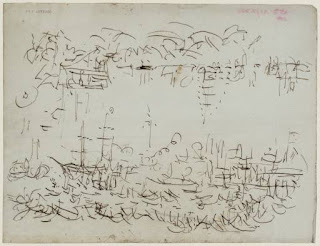the italics are my thoughts
Stephen Farthing talking about his work as the CCW Research Professor in Drawing.
Starting with a small drawing of a sort of ancient fort or burial ground Farthing explained how he is trying to understand all drawing through making a map or plan about drawing itself. He initially placed fine art in a central position on the landscape and all other types spreading out, reaching towards the act of writing which is set near the horizon. He later moved fine art to the outer circle of importance.
Searching for ways to organise his ideas and locate areas of flow he developed a type of underground map to describe connections as a Taxonomy of Drawing.
He discussed drawing as 2D representation, showing an example of an aeroplanes flat, outlined shadow, that should not be classed as drawing because it is made unintentionally. However a vapour trail heart, constructed by two planes as they fly in arcs through exact planning and measurement is drawing.
Searching for ways to organise his ideas and locate areas of flow he developed a type of underground map to describe connections as a Taxonomy of Drawing.
He discussed drawing as 2D representation, showing an example of an aeroplanes flat, outlined shadow, that should not be classed as drawing because it is made unintentionally. However a vapour trail heart, constructed by two planes as they fly in arcs through exact planning and measurement is drawing.
The heart image is a beautifully line, drawn in a transparent filigree the line dissolves in a fragile rhythmic pulse.
Drawings can be definitive or instructive, derived from observation, memory, mind and imagination.
Drawings can be definitive or instructive, derived from observation, memory, mind and imagination.
He gave an example of possibly the greatest drawing ever made, developed by a mathematician. An invented sundial that shadows the movement of planets, then translated into time using the kinetic element of a pendulum, this is made as a tonal drawing.
Sundial invention
Originally drawings may have developed from scribbling but physical gesture is probably the real beginning.
Stephen Farthing is looking at all methods and reasons for drawing. His Taxonomy of Drawing divides into two.
Conceptual - Drawings that need to be read via the rule book:
Maps, football pitch, Maori tattoos, because they are complicated and need explanation to enable other cultures to decode them. Roads developing c1920 have become massive drawings when seen with a birds eye view, a highway code is required to understand them.
Where do pathways that mark out routes on the landscape fit here?
Maps, football pitch, Maori tattoos, because they are complicated and need explanation to enable other cultures to decode them. Roads developing c1920 have become massive drawings when seen with a birds eye view, a highway code is required to understand them.
Where do pathways that mark out routes on the landscape fit here?
Pictorial - Turner draws a boat on a choppy sea, the latter is signified by rhythmic marks, developed through a keen observation into his method of seeing the world.
We understand the boat as we have learnt to read edges of things, therefore the water is easily understood.
We understand the boat as we have learnt to read edges of things, therefore the water is easily understood.
Turner's waves and boats sketch
Farthing’s map is a conceptual drawing but he also makes a pictorial version.
Two plan chests labelled Conceptual and Pictorial.
You can choose the correct chest to store any drawing in but first how do you decide if it is a drawing and to do this, is it important to know who the drawing is for?
You can choose the correct chest to store any drawing in but first how do you decide if it is a drawing and to do this, is it important to know who the drawing is for?
To categorise, it is important to ask first what was the point of that drawing?
A question discussed later - Is labelling valid?
I wonder if there is a grey area between the two, in which drawer does the abstract drawing fit?


No comments:
Post a Comment